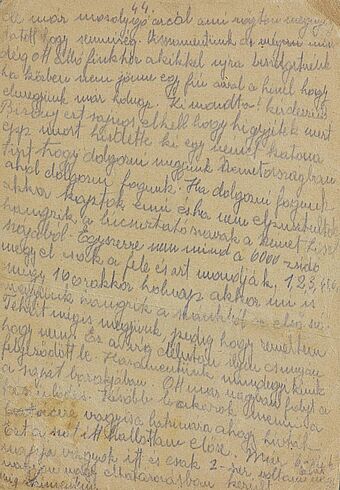Deported to Auschwitz - Sheindi Ehrenwald's notes
On display as of today in the Permanent Exhibition of the Deutsches Historisches Museum
Download
The 27th of January marks the 75th anniversary of the liberation of the Auschwitz-Birkenau concentration camp. More than a million people were murdered in the largest concentration camp of the Nazi regime, among them the Hungarian Jewish family of Sheindi Miller-Ehrenwald.
Sheindi Ehrenwald from the small town of Galánta, then 14 years old, began her diary on the day the German army occupied Hungary. She wrote about the deprivation of rights, about exclusion, ghettoisation and the deportation of her entire family in the freight car of a “special train” to Auschwitz-Birkenau. Upon their arrival in June 1944 Sheindi’s grandparents, parents and siblings were murdered by the SS. She and one of her sisters survived the selection and were forced to work in a factory run by the Karl Diehl armaments concern. Sheindi was able to preserve her notes on the back side of the firm’s discarded index cards. The notes are being shown at the exhibition space where the Auschwitz model of the Polish artist Mieczysław Stobierski (1914–1998) used to stand.
Parallel to this display, the fate of the Hungarian Jews is depicted by means of further artefacts and documents. The Deutsches Historisches Museum shows how the perpetrators had radically and rapidly planned, organised and carried out the mass deportation, exploitation and murder by the summer of 1944.
Sheindi Miller-Ehrenwald’s account is being presented to the public in Germany for the first time. The exhibition takes place in cooperation with BILD, which has documented the story in the video production “Sheindi’s Diary”. From 23rd of January to 30th of January 2020 the film can be seen daily at 3 pm in the Zeughauskino of the Deutschen Historischen Museum.

Vom Tagebuch übertragene Aufzeichnung von Sheindi Ehrenwald zur Ankunft im Vernichtungslager Auschwitz-Birkenau(Privatbesitz Sheindi Miller-Ehrenwald, Jerusalem
Vom Tagebuch übertragene Aufzeichnung von Sheindi Ehrenwald zur Ankunft im Vernichtungslager Auschwitz-Birkenau(Privatbesitz Sheindi Miller-Ehrenwald, Jerusalem